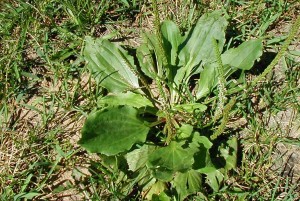Several years ago I attended an herbal conference, the Green Nation’s Gathering where the Wisconsin ethnobotanist Keewaydinoquay Peschel spoke about her years as a medicine woman. Specifically she spoke about how she used plantain to poultice bee stings in those who might be subject to anaphylactic shock, glass stuck in the neck, bug bites, even skin conditions.

One story she told stands out among all others. She had been lecturing about plantain to her ethnobotany class, and the mother of one of her students sat in on the class. Three years later she received a box from Florida. “I don’t know anyone in Florida she said.” The box was a present from the mother of the student. She had been gardening with her friends and all three had been bitten by a spider.  They soon went their separate ways and she noticed plantain growing along the walk. Remembering the lecture, she picked a few leaves and made a spit poultice which she placed over the bite. The next morning her friends were dead and, thanks to plantain, she was not.
They soon went their separate ways and she noticed plantain growing along the walk. Remembering the lecture, she picked a few leaves and made a spit poultice which she placed over the bite. The next morning her friends were dead and, thanks to plantain, she was not.
The idea that this plant which grows in every sidewalk crack can save a life is something that deeply impresses children I have taught and changes their relationship to plants in general. With its vibrant green leaves, vertical ribs and basal rosette, the plant is easy to identify. It ranges in size from an inch or two long to the size of a medium hosta. (In fact I have a border of plantains in the garden bordering my hostas- the poor man’s hosta!)
Plantain is cool, moist and has a mineral salt taste. It is a yin tonic that heals mucosal tissue. It especially is good for inflammation and ulceration the GI and genitourinary tract. It contains antibacterial baicalein and scutellarin, common to the anti-infective Chinese scutellaria plant. It also contains allantoin which we also find in comfrey root. It is high in flavanoids, tannins, and antioxidants. Plantain leaf is demulcent, emollient, mildly diuretic, styptic and vulnerary.
The seeds have different properties. In western medicine, the seeds of the related psyllium are taken as laxatives. In Chinese medicine, the seeds are made into a diuretic tea which may cure diarrhea. And while the Chinese plantain is slightly more astringent, the main difference is that the bulking properties of the seeds are filtered out when decocted. The seeds contain EFAs and zinc and are used for low sperm count, yang deficiency and impotence.
The leaves can be used to make salves for aches, pains and abrasions. I steep plantain leaves in olive oil for one client who has an inflamed GI tract and it is one of the only things she can tolerate internally. For others the plantain oil soothes the skin.
Plantain with St. John’s wort can be made into a salve for shingles or herpes, fissures, hemorrhoids, rashes and eczema. A poultice with plantain, indigo, and echinacea can be used for scorpion, spider or snake bites, changed regularly. And a tincture of the three, perhaps with additional coptis can be used for MRSA.
Although no plant is as common as plantain, it has the potential to save lives. Its virtue allows us to treasure the commonplace.
